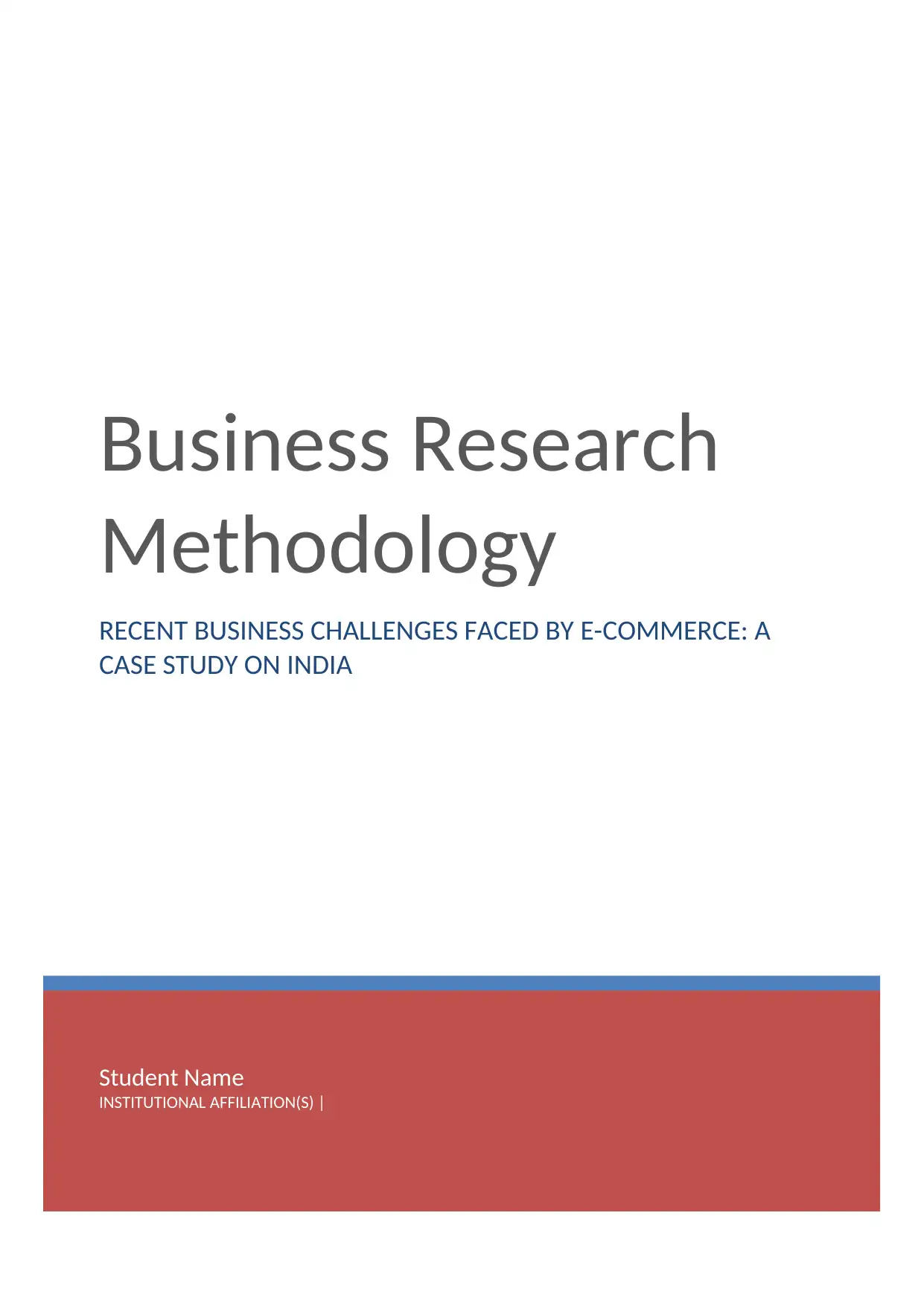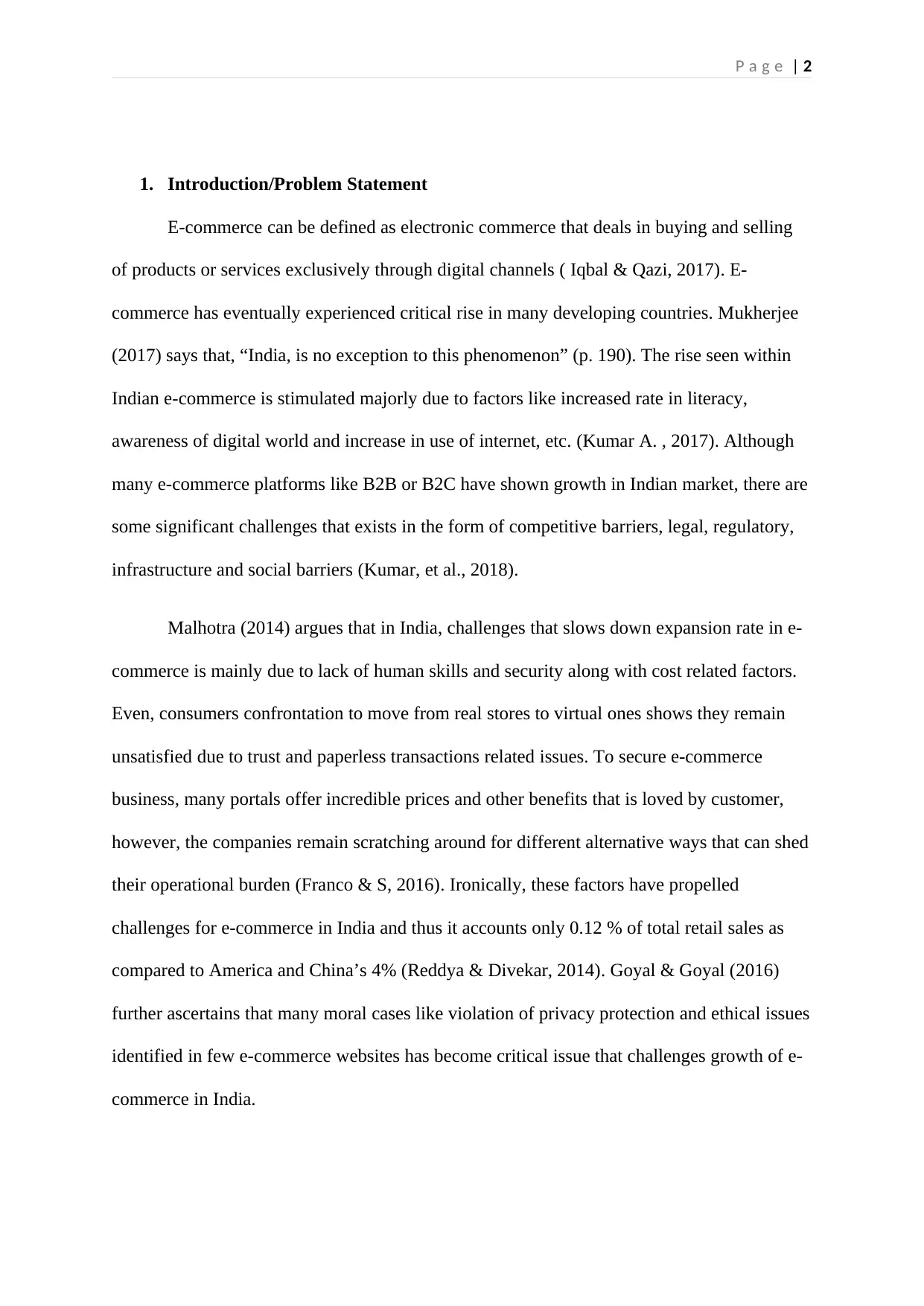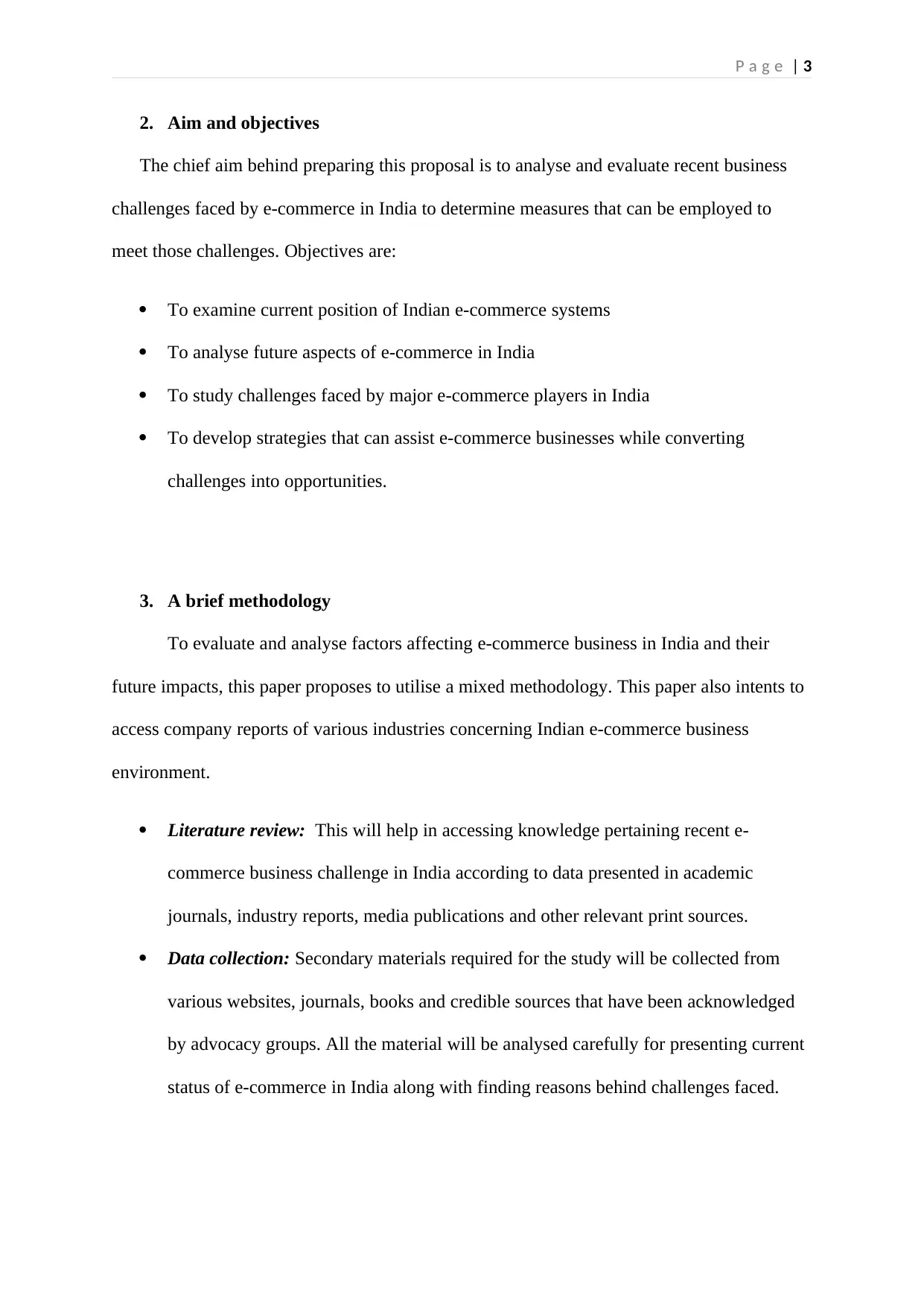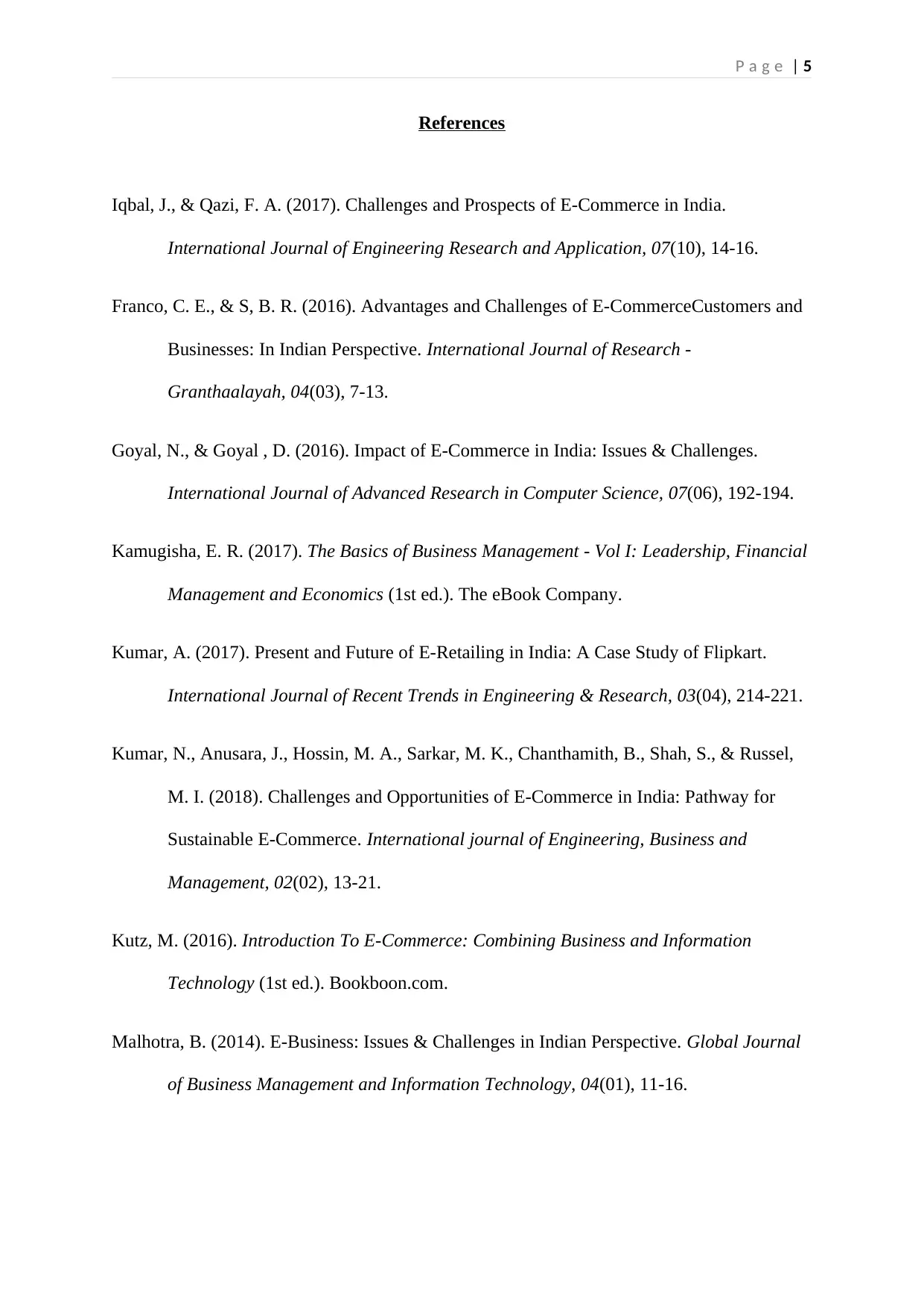BUSN20016: E-commerce Challenges in India - Case Study Analysis
VerifiedAdded on 2023/01/16
|7
|1227
|72
Report
AI Summary
This report provides an analysis of the recent business challenges faced by the e-commerce sector in India. The study begins by defining e-commerce and highlighting its growth in the Indian market, driven by increased literacy, digital awareness, and internet usage. Despite this growth, the report identifies significant challenges, including competitive barriers, legal and regulatory hurdles, infrastructure limitations, and social barriers like lack of consumer trust. The report aims to examine the current state of Indian e-commerce, analyze its future prospects, study the challenges faced by major e-commerce players, and develop strategies to convert challenges into opportunities. The methodology involves a mixed-methods approach, including literature reviews, data collection from various sources, and interviews with stakeholders. Secondary data analysis will involve a meta-analysis approach using company reports and legal frameworks, with data structured in tables for correlation analysis. The conclusion emphasizes the need to address infrastructure bottlenecks, payment gateway systems, and economic disparities to promote a successful e-commerce platform in India.

Student Name
INSTITUTIONAL AFFILIATION(S) |
Business Research
Methodology
RECENT BUSINESS CHALLENGES FACED BY E-COMMERCE: A
CASE STUDY ON INDIA
INSTITUTIONAL AFFILIATION(S) |
Business Research
Methodology
RECENT BUSINESS CHALLENGES FACED BY E-COMMERCE: A
CASE STUDY ON INDIA
Paraphrase This Document
Need a fresh take? Get an instant paraphrase of this document with our AI Paraphraser

P a g e | 1
Table of Contents
1
.Introduction/Problem Statement...............................................................................................2
2.Aim and objectives..................................................................................................................3
3.A brief methodology...............................................................................................................3
4.Secondary data and data analysis methods.............................................................................4
5.Conclusion...............................................................................................................................4
References..................................................................................................................................5
Table of Contents
1
.Introduction/Problem Statement...............................................................................................2
2.Aim and objectives..................................................................................................................3
3.A brief methodology...............................................................................................................3
4.Secondary data and data analysis methods.............................................................................4
5.Conclusion...............................................................................................................................4
References..................................................................................................................................5

P a g e | 2
1. Introduction/Problem Statement
E-commerce can be defined as electronic commerce that deals in buying and selling
of products or services exclusively through digital channels ( Iqbal & Qazi, 2017). E-
commerce has eventually experienced critical rise in many developing countries. Mukherjee
(2017) says that, “India, is no exception to this phenomenon” (p. 190). The rise seen within
Indian e-commerce is stimulated majorly due to factors like increased rate in literacy,
awareness of digital world and increase in use of internet, etc. (Kumar A. , 2017). Although
many e-commerce platforms like B2B or B2C have shown growth in Indian market, there are
some significant challenges that exists in the form of competitive barriers, legal, regulatory,
infrastructure and social barriers (Kumar, et al., 2018).
Malhotra (2014) argues that in India, challenges that slows down expansion rate in e-
commerce is mainly due to lack of human skills and security along with cost related factors.
Even, consumers confrontation to move from real stores to virtual ones shows they remain
unsatisfied due to trust and paperless transactions related issues. To secure e-commerce
business, many portals offer incredible prices and other benefits that is loved by customer,
however, the companies remain scratching around for different alternative ways that can shed
their operational burden (Franco & S, 2016). Ironically, these factors have propelled
challenges for e-commerce in India and thus it accounts only 0.12 % of total retail sales as
compared to America and China’s 4% (Reddya & Divekar, 2014). Goyal & Goyal (2016)
further ascertains that many moral cases like violation of privacy protection and ethical issues
identified in few e-commerce websites has become critical issue that challenges growth of e-
commerce in India.
1. Introduction/Problem Statement
E-commerce can be defined as electronic commerce that deals in buying and selling
of products or services exclusively through digital channels ( Iqbal & Qazi, 2017). E-
commerce has eventually experienced critical rise in many developing countries. Mukherjee
(2017) says that, “India, is no exception to this phenomenon” (p. 190). The rise seen within
Indian e-commerce is stimulated majorly due to factors like increased rate in literacy,
awareness of digital world and increase in use of internet, etc. (Kumar A. , 2017). Although
many e-commerce platforms like B2B or B2C have shown growth in Indian market, there are
some significant challenges that exists in the form of competitive barriers, legal, regulatory,
infrastructure and social barriers (Kumar, et al., 2018).
Malhotra (2014) argues that in India, challenges that slows down expansion rate in e-
commerce is mainly due to lack of human skills and security along with cost related factors.
Even, consumers confrontation to move from real stores to virtual ones shows they remain
unsatisfied due to trust and paperless transactions related issues. To secure e-commerce
business, many portals offer incredible prices and other benefits that is loved by customer,
however, the companies remain scratching around for different alternative ways that can shed
their operational burden (Franco & S, 2016). Ironically, these factors have propelled
challenges for e-commerce in India and thus it accounts only 0.12 % of total retail sales as
compared to America and China’s 4% (Reddya & Divekar, 2014). Goyal & Goyal (2016)
further ascertains that many moral cases like violation of privacy protection and ethical issues
identified in few e-commerce websites has become critical issue that challenges growth of e-
commerce in India.
⊘ This is a preview!⊘
Do you want full access?
Subscribe today to unlock all pages.

Trusted by 1+ million students worldwide

P a g e | 3
2. Aim and objectives
The chief aim behind preparing this proposal is to analyse and evaluate recent business
challenges faced by e-commerce in India to determine measures that can be employed to
meet those challenges. Objectives are:
To examine current position of Indian e-commerce systems
To analyse future aspects of e-commerce in India
To study challenges faced by major e-commerce players in India
To develop strategies that can assist e-commerce businesses while converting
challenges into opportunities.
3. A brief methodology
To evaluate and analyse factors affecting e-commerce business in India and their
future impacts, this paper proposes to utilise a mixed methodology. This paper also intents to
access company reports of various industries concerning Indian e-commerce business
environment.
Literature review: This will help in accessing knowledge pertaining recent e-
commerce business challenge in India according to data presented in academic
journals, industry reports, media publications and other relevant print sources.
Data collection: Secondary materials required for the study will be collected from
various websites, journals, books and credible sources that have been acknowledged
by advocacy groups. All the material will be analysed carefully for presenting current
status of e-commerce in India along with finding reasons behind challenges faced.
2. Aim and objectives
The chief aim behind preparing this proposal is to analyse and evaluate recent business
challenges faced by e-commerce in India to determine measures that can be employed to
meet those challenges. Objectives are:
To examine current position of Indian e-commerce systems
To analyse future aspects of e-commerce in India
To study challenges faced by major e-commerce players in India
To develop strategies that can assist e-commerce businesses while converting
challenges into opportunities.
3. A brief methodology
To evaluate and analyse factors affecting e-commerce business in India and their
future impacts, this paper proposes to utilise a mixed methodology. This paper also intents to
access company reports of various industries concerning Indian e-commerce business
environment.
Literature review: This will help in accessing knowledge pertaining recent e-
commerce business challenge in India according to data presented in academic
journals, industry reports, media publications and other relevant print sources.
Data collection: Secondary materials required for the study will be collected from
various websites, journals, books and credible sources that have been acknowledged
by advocacy groups. All the material will be analysed carefully for presenting current
status of e-commerce in India along with finding reasons behind challenges faced.
Paraphrase This Document
Need a fresh take? Get an instant paraphrase of this document with our AI Paraphraser

P a g e | 4
Interviews: The data collected will include interactions made with courier service
provides and suppliers to make an objective study of the proposed topic. This paper
also intents to interview stakeholders of e-commerce websites.
All the data will be combined together to assist further in preparing potential strategies to
convert challenges into opportunities in future years (Kutz, 2016).
4. Secondary data and data analysis methods
To determine the objectives of this paper, a meta-analysis approach will be employed
by using secondary materials and data collected through interviews made. Information
provided in literature reviews will specify demographic characteristics of consumers using e-
commerce for shopping. Company reports of e-commerce facilitators in India and legal
frameworks will be collected to ensure implementation of sustainable e-commerce business.
The collected data, including demographic variables and legal framework will be
structured in table format to confirm appropriate correlation analysis and find reasons behind
challenges faced like logistics, vendor management, taxation and payment collection.
5. Conclusion
E-commerce act as an alternative marketing channel, but the business challenges
faced by Indian companies lags them behind other developed countries (Kamugisha, 2017).
Infrastructure bottlenecks, payment gateway systems and economic disparity are few areas
that needs to be addressed critically by stakeholders for promoting successful e-commerce
platform in India.
Interviews: The data collected will include interactions made with courier service
provides and suppliers to make an objective study of the proposed topic. This paper
also intents to interview stakeholders of e-commerce websites.
All the data will be combined together to assist further in preparing potential strategies to
convert challenges into opportunities in future years (Kutz, 2016).
4. Secondary data and data analysis methods
To determine the objectives of this paper, a meta-analysis approach will be employed
by using secondary materials and data collected through interviews made. Information
provided in literature reviews will specify demographic characteristics of consumers using e-
commerce for shopping. Company reports of e-commerce facilitators in India and legal
frameworks will be collected to ensure implementation of sustainable e-commerce business.
The collected data, including demographic variables and legal framework will be
structured in table format to confirm appropriate correlation analysis and find reasons behind
challenges faced like logistics, vendor management, taxation and payment collection.
5. Conclusion
E-commerce act as an alternative marketing channel, but the business challenges
faced by Indian companies lags them behind other developed countries (Kamugisha, 2017).
Infrastructure bottlenecks, payment gateway systems and economic disparity are few areas
that needs to be addressed critically by stakeholders for promoting successful e-commerce
platform in India.

P a g e | 5
References
Iqbal, J., & Qazi, F. A. (2017). Challenges and Prospects of E-Commerce in India.
International Journal of Engineering Research and Application, 07(10), 14-16.
Franco, C. E., & S, B. R. (2016). Advantages and Challenges of E-CommerceCustomers and
Businesses: In Indian Perspective. International Journal of Research -
Granthaalayah, 04(03), 7-13.
Goyal, N., & Goyal , D. (2016). Impact of E-Commerce in India: Issues & Challenges.
International Journal of Advanced Research in Computer Science, 07(06), 192-194.
Kamugisha, E. R. (2017). The Basics of Business Management - Vol I: Leadership, Financial
Management and Economics (1st ed.). The eBook Company.
Kumar, A. (2017). Present and Future of E-Retailing in India: A Case Study of Flipkart.
International Journal of Recent Trends in Engineering & Research, 03(04), 214-221.
Kumar, N., Anusara, J., Hossin, M. A., Sarkar, M. K., Chanthamith, B., Shah, S., & Russel,
M. I. (2018). Challenges and Opportunities of E-Commerce in India: Pathway for
Sustainable E-Commerce. International journal of Engineering, Business and
Management, 02(02), 13-21.
Kutz, M. (2016). Introduction To E-Commerce: Combining Business and Information
Technology (1st ed.). Bookboon.com.
Malhotra, B. (2014). E-Business: Issues & Challenges in Indian Perspective. Global Journal
of Business Management and Information Technology, 04(01), 11-16.
References
Iqbal, J., & Qazi, F. A. (2017). Challenges and Prospects of E-Commerce in India.
International Journal of Engineering Research and Application, 07(10), 14-16.
Franco, C. E., & S, B. R. (2016). Advantages and Challenges of E-CommerceCustomers and
Businesses: In Indian Perspective. International Journal of Research -
Granthaalayah, 04(03), 7-13.
Goyal, N., & Goyal , D. (2016). Impact of E-Commerce in India: Issues & Challenges.
International Journal of Advanced Research in Computer Science, 07(06), 192-194.
Kamugisha, E. R. (2017). The Basics of Business Management - Vol I: Leadership, Financial
Management and Economics (1st ed.). The eBook Company.
Kumar, A. (2017). Present and Future of E-Retailing in India: A Case Study of Flipkart.
International Journal of Recent Trends in Engineering & Research, 03(04), 214-221.
Kumar, N., Anusara, J., Hossin, M. A., Sarkar, M. K., Chanthamith, B., Shah, S., & Russel,
M. I. (2018). Challenges and Opportunities of E-Commerce in India: Pathway for
Sustainable E-Commerce. International journal of Engineering, Business and
Management, 02(02), 13-21.
Kutz, M. (2016). Introduction To E-Commerce: Combining Business and Information
Technology (1st ed.). Bookboon.com.
Malhotra, B. (2014). E-Business: Issues & Challenges in Indian Perspective. Global Journal
of Business Management and Information Technology, 04(01), 11-16.
⊘ This is a preview!⊘
Do you want full access?
Subscribe today to unlock all pages.

Trusted by 1+ million students worldwide

P a g e | 6
Mukherjee, S. (2017). E-Commerce and SMEs: A Case study of India. International Journal
of Commerce, Business and Management, 06(02), 190-198.
Reddya, N. A., & Divekar, R. (2014). A Study Of Challenges Faced By E-Commerce
Companies In India And Methods Employed To Overcome Them. Procedia
Economics and Finance, 11, 553-560.
Mukherjee, S. (2017). E-Commerce and SMEs: A Case study of India. International Journal
of Commerce, Business and Management, 06(02), 190-198.
Reddya, N. A., & Divekar, R. (2014). A Study Of Challenges Faced By E-Commerce
Companies In India And Methods Employed To Overcome Them. Procedia
Economics and Finance, 11, 553-560.
1 out of 7
Related Documents
Your All-in-One AI-Powered Toolkit for Academic Success.
+13062052269
info@desklib.com
Available 24*7 on WhatsApp / Email
![[object Object]](/_next/static/media/star-bottom.7253800d.svg)
Unlock your academic potential
Copyright © 2020–2025 A2Z Services. All Rights Reserved. Developed and managed by ZUCOL.





